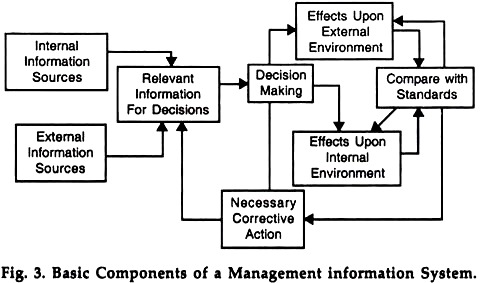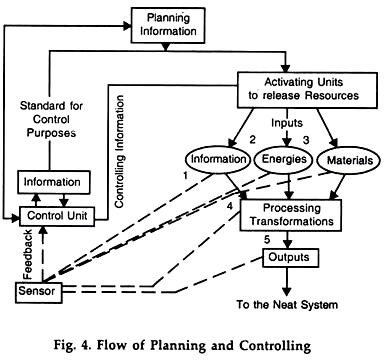This article provides an overview on Management Information System (MIS).
Information System:
It is a system which provides each manager in the organisation with the information he needs in order to take decisions, plan and control within his area of responsibility. Information system is an organised way of sending, receiving and recording messages.
It includes both formal flow of information as well as informal flow of information, called grapevine. Ideally, information should be accurate, adequate, up to date, reliable, timely and understandable. In our system of information there should be no overlaps, no gaps and no contradictions.
There are three areas of management information system:
ADVERTISEMENTS:
(1) Decision making,
(2) Planning and
(3) Control.
A manager needs information primarily to make timely and informed decisions. Information is now regarded as a basic resource of the organisation along with other resources such as personnel, money, materials, machines, and facilities. Information is critical or crucial resource to the success of the enterprise. It must be at the right place and at the right time.
ADVERTISEMENTS:
There are three major areas of information system:
(1) Financial information;
(2) Personnel information;
(3) Logistics information physical flow of goods through an organisation, etc.
ADVERTISEMENTS:
Logistics function covers such activities as purchasing, receiving, inventory and distribution.
Note:
1. Management Information System (MIS) is a federation of subsystems based on functions performed in an organisation:
ADVERTISEMENTS:
1. Marketing Information,
2. Production,
3. Logistic i.e., buying, receiving, inventory and distribution,
4. Personnel,
ADVERTISEMENTS:
5. Finance and Accounting,
6. Top Management Information, and
7. Information Processing.
2. A manager plus the decision procedures for directing an activity is called decision centre.
ADVERTISEMENTS:
3. Decision centre plus activity is called a functional unit.
4. A number of functional units connected with a network of information flows is called an organisation in designing an information system. Sensory devices to measure performance or output are put at five strategic points in the system flow to measure performance or output.
Sensor gets data from these five points as shown by five dotted lines. The control unit on the basis of feedback compares actual performance with standards. Information to correct deviations is given to activating units which makes corrections.
In operation and control, and inputs are inputs of information (for ex-ample customer data, prices, discounts, delivery dates), inputs of energy (energy exerted by workers or energy used to operate machines), or inputs of materials (raw materials, invoice forms). (See Fig. 4)
Computer is at present looking after management information system. Management can get large quantities of information rapidly. There are five control points in the diagram, the final one measuring the output itself. Other control points measure resources and also processing. Sensor is the unit to measure performance or result. (See Fig. 4)
Information has been defined as the cues or guidelines which have the potential to influence managerial decisions. A manager is a decision maker. Information provides the means by which problems are recognised, defined, and eventually solved, if the information is better, more complete, more reliable and timely, it is easier for the manager to make a final decision.
Lower management is interested in operational information, e.g., detailed reports generally control-oriented, for taking operational decisions.
Middle management is interested in tactical information, e.g., comprehensive reports basically planning/control-oriented, for taking tactical decisions. Top management wants strategic information, e.g., overall reports fundamentally planning oriented, for taking strategic decisions.
Hence, we need a good marketing information system continuously as an ongoing process to facilitate sound marketing decisions on marketing plans, policies and programme.
Marketing Information:
Basically, marketing information system is an interacting, continuing, future-oriented structure of persons, machines, and procedures designed to generate an orderly flow of information collected from internal and external sources, for uses as the bases for managerial decision making in any area of company’s marketing management.
ADVERTISEMENTS:
A marketing information system continuously gathers data, i.e., facts and figures from the internal and external sources of information. Then this information is sorted out, classified, analysed and stored for future reference. The stored information can be recalled or restored immediately for reference in the form required for decision making by marketers.
Characteristics of MIS:
1. MIS is a consciously developed master plan for information flow. It is an ongoing process. It operates continuously.
2. We have the best integration and coordination among functional departments, executives and specialists such as systems analyst, programmer, and computer expert.
3. We have some kind of data processing equipment usually operated electronically. The computer is the modern equipment for MIS.
4. MIS is future oriented. It anticipates and prevents problems as well as it solves marketing problems. It is both a preventive as well as curative process in marketing.
5. The gathered data is processed with the help of management science or operations research techniques. Modern mathematical and statistical tools are available for problem solving in the field of marketing.
ADVERTISEMENTS:
6. Systems analyst designs and operates MIS. It is operated through computers. Operations research analyst offers solutions to the marketing problem with the help of quantitative decision making tools.
7. Management gets a steady flow of information on a regular basis the right information, for the right people, at the right time and cost.

